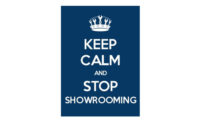How to bring customers back to brick-and-mortar showrooms


Ben Alliker has been in the decorative plumbing and hardware industry since 2003, after eight years practicing law.


Since the dawn of the internet, products have been available for purchase online. For those of us in the decorative plumbing showroom business, we historically have had an “us vs. them” mentality about the web-based retailer. After recognizing their presence was not just a fad or passing phase, we have watched fears become reality as the “e-tailer” would steal sales from the showroom because they offer the same products we sell at cheaper-than-cheap pricing.
Like the proverbial mustached “bad guy” from a 1920’s movie, the internet retailer “waits” around the corner, ready to pounce on us. The “good guy” showroom is the victim – doing all the hard work with the customer – breaking the ice, building rapport, qualifying the customer, identifying their needs, presenting them with options, helping them with selections, refining and revisiting the quote multiple times, providing product images and specifications.
Then, just when the showroom is about to close the deal, and the customer is ready to pay, the “bad guy” springs on us, shows our customer “cheaper pricing” and steals the customer away on price.
By taking an “us vs. them” approach, we have created a self-fulfilling prophecy – by demonizing the e-tailer, we have created our own enemy and even given them the power to steal the sales. E-tailers found a fundamental flaw in our process. We created a need for a better experience – by rundown showrooms, tired looking displays and more often by the poor and sometimes terrible customer experiences in brick- and-mortar showrooms. E-tailers made it easy and cheaper to purchase products.
But instead of seeing this as an alarm to improve how we do business, we kept on doing business the same way. And guess what? Customers started “showrooming” our products – coming in to see displays, talk to our sales teams to get advice and information, and then bought their goods online. And one of the great ironies to this – e-tailers now are creating their own brick-and-mortar stores to bring a retail experience based on what they saw and learned from us.
By recognizing a few fundamental truths about today’s customer and today’s retail landscape, we in existing brick-and-mortar showrooms can survive and even thrive – getting the customers back in our stores and purchasing the products we sell in our showrooms.
Price competition existed long before the internet
The internet did not invent price competition, deep discounts and rebates, or free delivery. Customers always, at least in competitive markets, shopped pricing and quotes around town – always in search of a better deal. By focusing on this aspect of the sale, the e-tailer made the customer feel as if they could get “a win.” The e-tailer just gave a lower price – that’s all. It came in the form of a better discount, free delivery, the avoidance of sales tax. The customer, able to find a better price “on their own,” believed that the showroom was “cheating” or “taking advantage” – otherwise, how could they find it online for less? Sound familiar?
Internet retailers are not boogeymen
Let’s unravel this. Today’s shoppers predominantly believe that a showroom’s price will be higher than one they can find on the internet. That is 100% wrong. I can tell you from firsthand experience managing several high-end decorative plumbing and hardware showrooms that the showroom pricing can be, and usually is, better than the internet pricing.
Today, many retailers will offer price-matching for customers, but more often can beat that pricing. Most manufacturers that are showroom friendly have published and enforced a MAP policy that makes sense, or will provide deeper discounts to the showroom to enable them to give a better discount when necessary to compete with online retailers. Even in the last year, industry stalwarts such as Kohler and Hansgrohe – renowned for cheap internet pricing – have created a more level playing field for the showrooms that carry their products.
A good exercise for showroom managers is to look at those products you carry and check their discount structures offered by online retailers, and for those offering huge discounts on the internet, ask yourself why you still have them as a part of your product offering. It may no longer make sense to carry that line.
Deconstructing price advantage
I often hear from colleagues that this is wonderful and often true – but that once free delivery and no sales tax are factored in, the showroom still loses the customer on the bottom-line pricing. Thankfully, we will undoubtedly be seeing states enforce the collection of sales tax on internet dealers thanks to the recent Supreme Court decision in North Dakota v. Wayfair a few weeks ago. So the only significant advantage left for the internet retailer is free delivery.
Many showrooms already offer free delivery on large orders (however that is defined) and/or have relatively minor or standard delivery fees. If you don’t, consider giving a customer a deal – such as no-charge UPS for roughs or smaller items, and charging the delivery fee for larger items likes vanities and tubs and toilets. Sometimes doing two deliveries for the price of one delivery is usually is enough to seal the deal.
The real problem is us
But all this misses the issue at the heart of the problem. We have too often sat on our laurels and not kept up with the demands of our customers. That is what allowed the internet retailer to become successful. We failed, as a group and individually, to provide the right POW retail experience for our customers to create engaged and loyal customers who want to buy from the showroom.
We filled our showrooms with lots of product – to the point that our customers’ eyes glazed over. We overwhelmed them with too many faucets, or too many toilets, or too many light fixtures.
The good news – we have the tools at our fingertips to create that experience now and bring the customers back to us and give us a real advantage over all of our competition.
Relentlessly engaging and friendly staff
First, we need to give the customer an incredible in-store experience. A staff that has been trained specifically on how to greet, speak to, listen to and engage with customers will always beat out an impersonal interaction on the computer.
But too often the showroom experience is a disaster for the customer. We all hear the complaints — “nobody said hello” or “nobody offered me a glass of water even though I was seven months pregnant” or “offered me some better priced options.” And with the popularity of Yelp and other websites where we can review experiences, shoppers are not afraid to tell everyone about the poor staff or experience they had.
This, again, makes us afraid of the internet and makes us want to avoid it. But putting our head in the sand has only made us stagnant at best.
Salespeople are pleasers — we need to give them the tools to please today’s customers as a way to break the ice. But this alone will not guarantee sales. We all saw from the Pirch experiment that coffee bars alone will not make the sale happen. Coffee or juice or refreshments are just the beginning — we have to have our “secret sauce” ready to go and take the customer to the next step.
That starts with a sales team that is trained on how to engage with the customer on their level, listen to them and convey a sincere desire to help find what the customer is looking to buy. Smart showrooms are training their staffs on how to read and engage shoppers. Too few of us are investing in our staff to train the skills of customer engagement. We have to get better at it.
Use the internet as a tool to build trust
Another tool should be a computer — or more appropriately — the internet. Today’s customer is smart and computer savvy — likely having done a lot of research before they have walked into the showroom.
By creating work spaces where the customer can share the computer screen with the salesperson, we level the playing field and get ourselves on the “customer’s team” rather than being across from them divided by a sales counter.
We can empower the customer by letting them “show us” what they have already seen and found in their research. Once the customer and salesperson start working at the computer together — looking on the internet at products, Houzz, or whatever website the customer wants to show the salesperson — we are on the road to creating a better shopping experience.
This does two additional important things — (1) it demonstrates the relationship is with the salesperson, not the computer or website and (2) it shows the customer that the showroom has nothing to hide. This in turn creates trust between the customer and the salesperson. The salesperson can show the customer other websites to investigate at home, where to do product research – recreating the salesperson into an adviser and trusted counselor in the sales experience. Customers will come back for more of that good guidance.
Working displays work
For showrooms who tried to “step it up” — we have focused on working displays. And this tool works — if you can try on a pair of shoes before you buy them, why not a showerhead? Some showrooms give customers the ability to use the working products on the showroom floor before, during or after business hours. That is a fabulous way to give the customer a real-world experience that no website can offer.
Lending showerheads to customers to try at home always works. And of course we often forget our most effective display that 99% of us have already under our noses — the men’s and women’s bathrooms. If your store bathroom is worth its salt, it has the products you carry in it — and they are in working condition. It could be the best display you have – and often times during an interaction with customers, a good salesperson will end up in the bathroom with the customer showing them the way a toilet flushes or how a laminar flow faucet works. But again, taken alone, they are not enough to get the job done.
Have a website that looks and feels like your showroom
A website should be a seamless extension of the showroom and vice-versa. Think Apple. Customers need us to keep things simple — consistent branding, design, looks, fonts and colors, make it easy on the customers’ eyes. By enabling customers to shop with you on your website, review the status of their orders, check in with their salesperson or customer service, all make it an easier buying experience.
In many ways, we have to do more than just show pretty pictures of our showrooms.
Let’s take it to the next level. Imagine if the pretty picture of your newest display had a “click to buy” function that enabled customers to purchase from your displays in-store. Now that is a seamless and merged online and brick-and-mortar experience that everyone can love.
Today’s customer is no long willing to “call customer service” and wait. They don’t have to do that with Amazon or Walmart or wherever else they are shopping online. Imagine if your customer could do everything they need to check their order or shipping status right on your company’s website.
Smart showrooms are putting this to work now and making it easy for customers to get the information they need once they have placed an order.
Be your customers’ clearing house
Why should Houzz or Pinterest be the only ones with a “likebook” or place for customers to gather product images of things they like? Your website can be a customer’s platform for images – either imported from all sites into one or out of images from your site. Provide a place for customers to “do what they like to do” online. Give them a place where they can interact and control. Let them show you what designs and styles they are going for by having a place for them to work. This re-inserts the showroom back into the middle of the sales process.
Many programs now exist where you can provide a simple bathroom and kitchen layout and plug products into those programs to create a rendering of the space. Your showroom staff (or even your website) can offer it. The more a customer is linked to your site or works with your team to have their product selections, and the easier we make it for them to envision what they and we are creating together, the more ownership they have over the process, the more involved they will feel and the more happily they will do business.
Kick it up two notches with virtual reality
Design firms (and even a few showrooms) now use virtual reality equipment and programs to take the customer’s selections and plans to create a virtual bathroom, kitchen or living space. The customer can walk around the space and make changes without investing a penny in construction. Customers always are saying they cannot “visualize” how everything looks together — like the tile, tub and vanity all in one space. Let’s help them see it so they don’t have to guess if what they picked will work in the end. Creating that peace of mind translates into creating business.
Many will ask who is going to pay for all this. Part of the answer is that investing in your website and technology is required by today’s customer and if we want to stay relevant we have to invest in the things that will give them the experiences they are demanding. This is just as important as investing in displays.
Some tools can and should be used as a part of any sale and customer transaction — such as sharing the computer with the customer during the sales process. But others, like a virtual reality presentation, may only be for those who place their orders or for those who pay separately for that service.
Some showrooms may want to offer it as a service fee that becomes reduced when the ultimate order is placed. It’s up to you and your leadership team to figure out when, where and how to use these tools. But you can be sure that word of mouth, and of course, advertising the showroom sales experience you offer will bring the customers back to the showroom.
The internet has changed the face of our showroom retail landscape. There is no doubt about that. If we are willing to engage our customers where they are today and use the options available through technology and the internet to our advantage, then we can be the disruptors.
We are the experts in our field. We can bring a WOW shopping experience into our showrooms that can amaze and dazzle our customers, and blow away the competition. Let’s empower our sales teams to show customers that we are the real product experts and that their input is essential for any home renovation project and purchase, no matter how large or small.
By embracing the internet and technology, we will ensure a strong future for the very places we have worked so hard to build.
Looking for a reprint of this article?
From high-res PDFs to custom plaques, order your copy today!







